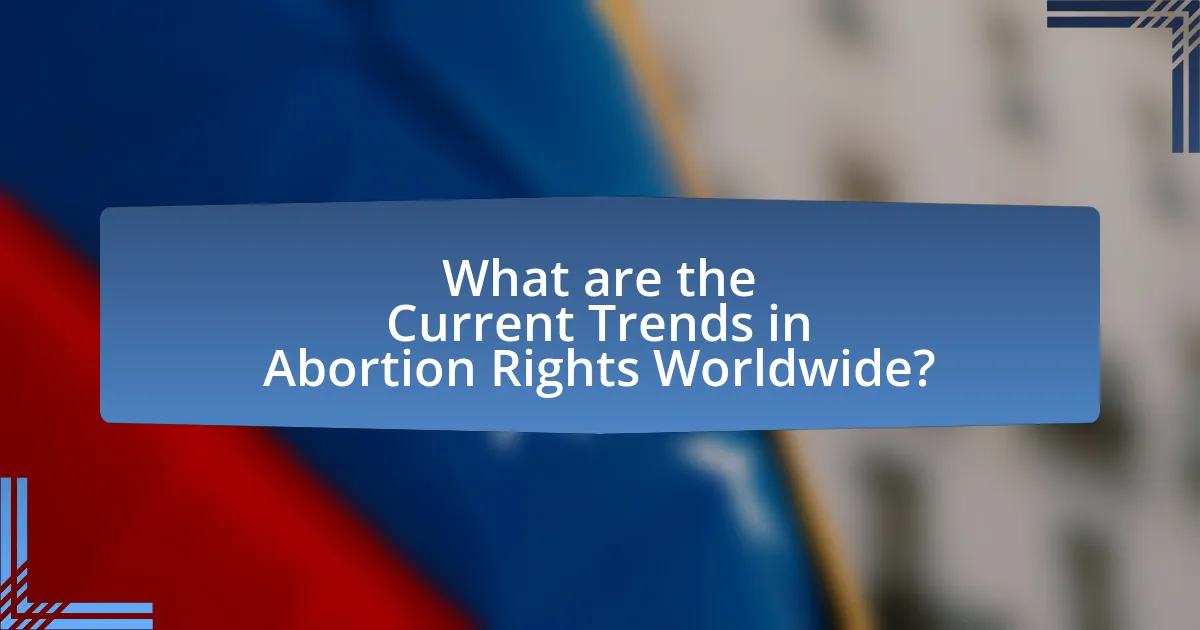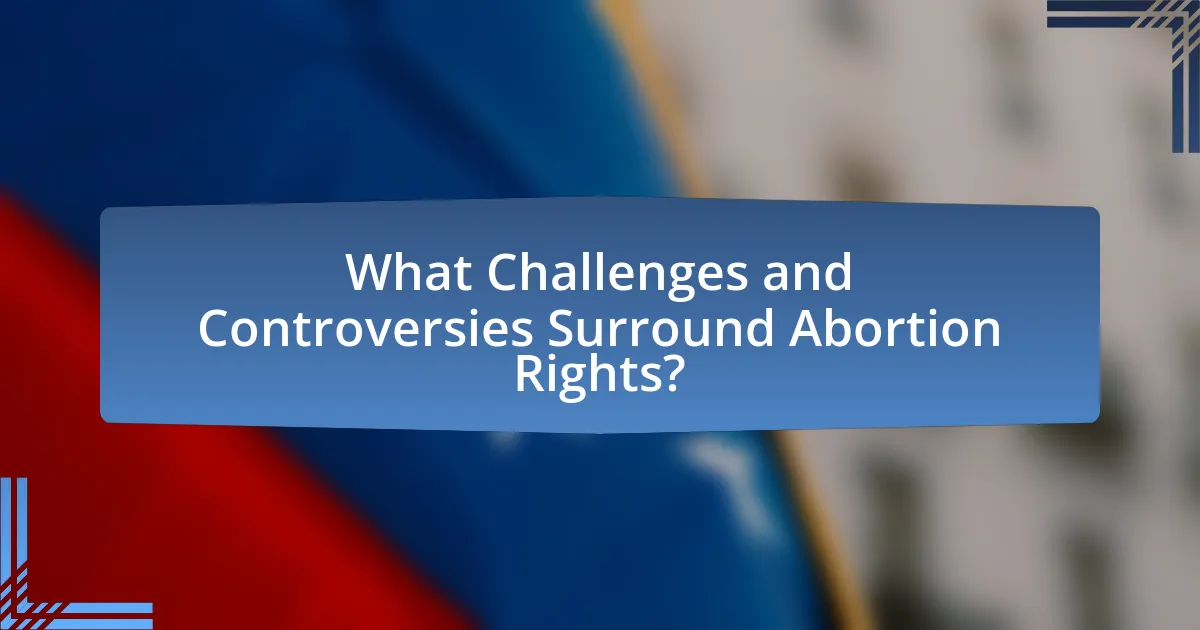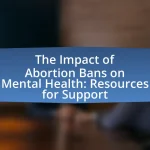Abortion rights encompass the legal and ethical entitlements of individuals to access safe and legal abortion services, significantly impacting women’s health, autonomy, and equality worldwide. The article examines the varying definitions and legal frameworks of abortion rights across different countries, highlighting the influence of cultural attitudes, historical contexts, and socio-economic factors on access to these services. It also discusses the role of international organizations and NGOs in advocating for reproductive rights, the challenges and controversies surrounding abortion, and the ethical considerations involved in the debate. Furthermore, the article outlines current trends in abortion rights, identifying both restrictive and progressive nations, and emphasizes the importance of supporting abortion rights globally through advocacy and education.

What are Abortion Rights and Why Do They Matter Globally?
Abortion rights refer to the legal and ethical entitlements of individuals to access safe and legal abortion services. These rights matter globally because they directly impact women’s health, autonomy, and equality. According to the World Health Organization, unsafe abortions contribute to approximately 47,000 deaths annually, highlighting the critical need for accessible abortion services to protect women’s lives. Furthermore, countries that uphold abortion rights often see improved health outcomes and gender equality, as evidenced by research from the Guttmacher Institute, which indicates that access to reproductive health services, including abortion, is essential for women’s empowerment and socio-economic development.
How are abortion rights defined in different countries?
Abortion rights vary significantly across countries, reflecting diverse legal, cultural, and religious contexts. In countries like Canada and the Netherlands, abortion is legal and accessible, often without restrictive conditions, allowing individuals to make choices about their reproductive health. Conversely, nations such as El Salvador and Nicaragua impose strict bans on abortion, even in cases of rape or health risks, leading to severe legal consequences for those who seek or provide abortion services.
In the United States, the legal landscape has shifted with the overturning of Roe v. Wade in 2022, resulting in varying state laws that either protect or restrict access to abortion. Countries like Germany and France allow abortion under specific conditions, typically within the first trimester, while requiring counseling or waiting periods.
These differences illustrate how abortion rights are defined by a combination of legal frameworks, societal values, and political climates, impacting women’s autonomy and health outcomes globally.
What legal frameworks govern abortion rights worldwide?
Legal frameworks governing abortion rights worldwide vary significantly by country and region, reflecting diverse cultural, religious, and political contexts. In many countries, laws are categorized into three main frameworks: total prohibition, conditional legality, and unrestricted access. For instance, countries like El Salvador and Nicaragua have total bans on abortion, while nations such as Canada and the Netherlands allow unrestricted access. Conditional legality is seen in countries like India and South Africa, where abortion is permitted under specific circumstances, such as health risks or socio-economic factors. These frameworks are often influenced by international human rights treaties, such as the Convention on the Elimination of All Forms of Discrimination Against Women, which advocates for women’s reproductive rights.
How do cultural attitudes influence abortion rights?
Cultural attitudes significantly influence abortion rights by shaping societal norms, legal frameworks, and political discourse surrounding the issue. In countries where conservative cultural values prevail, such as in many parts of Latin America and Africa, restrictive abortion laws often reflect the predominant belief that life begins at conception, leading to limited access to abortion services. Conversely, in more liberal societies, like those in Western Europe and parts of North America, cultural attitudes that prioritize individual autonomy and reproductive rights have resulted in more permissive abortion laws. For instance, a 2021 study published in the journal “Social Science & Medicine” found that countries with higher levels of gender equality and progressive cultural attitudes tend to have more supportive legal frameworks for abortion, demonstrating a clear correlation between cultural beliefs and the legal status of abortion rights.
What are the historical contexts of abortion rights in various regions?
The historical contexts of abortion rights vary significantly across different regions, shaped by cultural, legal, and political factors. In the United States, the landmark 1973 Supreme Court case Roe v. Wade established a constitutional right to abortion, reflecting a shift towards reproductive rights amidst the women’s liberation movement. In contrast, many Latin American countries maintain strict abortion laws influenced by Catholicism, with countries like El Salvador enforcing total bans, leading to severe legal repercussions for women.
In Europe, abortion rights are generally more liberal, with countries like Sweden and the Netherlands allowing abortions on demand within certain gestational limits, reflecting progressive social attitudes. Conversely, in regions like Africa, abortion laws are often restrictive; for instance, in Nigeria, abortion is largely illegal except to save a woman’s life, influenced by traditional beliefs and legal frameworks.
Asia presents a mixed picture; for example, in India, the Medical Termination of Pregnancy Act of 1971 legalized abortion under specific circumstances, while in countries like Afghanistan, recent political changes have led to increased restrictions on women’s rights, including access to abortion. These regional differences highlight the complex interplay of historical, cultural, and legal factors that shape abortion rights globally.
How have abortion rights evolved over the last century?
Abortion rights have evolved significantly over the last century, transitioning from widespread criminalization to increased legalization and access in many countries. In the early 20th century, most nations prohibited abortion, with few exceptions, reflecting societal norms that prioritized fetal rights over women’s autonomy. The landmark 1973 U.S. Supreme Court case Roe v. Wade established a constitutional right to abortion, influencing global perspectives and prompting many countries to reconsider their laws. By the late 20th and early 21st centuries, numerous nations, including Canada and several European countries, liberalized their abortion laws, allowing for greater access and reproductive rights. According to the World Health Organization, as of 2021, 56 countries have liberalized their abortion laws, reflecting a growing recognition of women’s rights and health needs.
What significant milestones have shaped abortion rights globally?
Significant milestones that have shaped abortion rights globally include the 1973 U.S. Supreme Court decision in Roe v. Wade, which legalized abortion nationwide, influencing many countries to reconsider their laws. In 1994, the International Conference on Population and Development in Cairo recognized reproductive rights, including access to safe abortion, as essential to women’s health. The 2018 ruling by the Irish government to repeal the Eighth Amendment, which heavily restricted abortion, marked a pivotal change in a traditionally conservative society. Additionally, the 2021 decision by the Mexican Supreme Court decriminalizing abortion in certain circumstances further advanced reproductive rights in Latin America. These milestones reflect a broader trend towards recognizing and protecting women’s reproductive rights worldwide.

What are the Current Trends in Abortion Rights Worldwide?
Current trends in abortion rights worldwide indicate a significant shift towards liberalization in many regions, with countries like Argentina and Ireland recently legalizing abortion. In contrast, several U.S. states have enacted restrictive laws following the Supreme Court’s decision to overturn Roe v. Wade in 2022, leading to increased advocacy for reproductive rights. According to the Guttmacher Institute, as of 2023, 26 countries have expanded access to abortion in the past decade, reflecting a growing recognition of reproductive rights as essential to gender equality and public health.
How do abortion laws vary across different continents?
Abortion laws vary significantly across different continents, reflecting diverse cultural, religious, and political contexts. In North America, for example, countries like Canada allow abortion on demand, while the United States has a patchwork of laws that vary by state, with some states imposing strict regulations. In Europe, many countries, such as the United Kingdom and France, permit abortion with gestational limits, whereas nations like Poland have implemented stringent restrictions. In Asia, countries like India allow abortion under specific circumstances, while others, such as the Philippines, have near-total bans. Africa presents a mixed landscape; South Africa has liberal laws, while many other nations impose severe restrictions. Latin America is characterized by restrictive laws in countries like El Salvador, contrasting with more liberal approaches in places like Uruguay. These variations illustrate the complex interplay of legal frameworks and societal values regarding abortion across the globe.
What are the most restrictive countries regarding abortion rights?
The most restrictive countries regarding abortion rights include El Salvador, Nicaragua, and Malta. In El Salvador, abortion is completely banned without exceptions, leading to severe legal consequences for women and healthcare providers. Nicaragua also enforces a total ban on abortion, even in cases of rape or when the mother’s life is at risk. Malta prohibits abortion under all circumstances, making it one of the most restrictive nations in Europe. These countries exemplify stringent legal frameworks that severely limit access to abortion services.
Which countries have made significant progress in expanding abortion rights?
Countries that have made significant progress in expanding abortion rights include Argentina, which legalized abortion up to 14 weeks in December 2020, and Ireland, which repealed its abortion ban in 2018, allowing access under various circumstances. Additionally, Mexico has seen various states decriminalize abortion, with the Supreme Court ruling in 2021 that criminalizing abortion is unconstitutional. These changes reflect a broader trend towards recognizing reproductive rights in these nations.
What role do international organizations play in abortion rights advocacy?
International organizations play a crucial role in abortion rights advocacy by promoting policies that support reproductive health and rights globally. These organizations, such as the World Health Organization (WHO) and the United Nations (UN), provide guidelines, research, and funding to improve access to safe abortion services. For instance, the WHO’s guidelines emphasize the importance of safe abortion as a critical component of comprehensive reproductive health care, which is supported by evidence showing that access to safe abortion reduces maternal mortality rates. Additionally, international organizations often collaborate with local governments and NGOs to advocate for legal reforms and to raise awareness about the importance of reproductive rights, thereby influencing national policies and practices.
How do NGOs influence abortion policy in various nations?
NGOs influence abortion policy in various nations through advocacy, education, and legal support. These organizations often mobilize public opinion, lobby governments, and provide resources to promote reproductive rights. For instance, in countries like Ireland, NGOs played a crucial role in the repeal of the Eighth Amendment, which restricted abortion access, by organizing campaigns and raising awareness about women’s health issues. Additionally, NGOs such as Planned Parenthood and the International Planned Parenthood Federation provide data and research that inform policymakers about the implications of restrictive abortion laws, thereby shaping legislative changes. Their efforts have led to significant policy shifts in several nations, demonstrating the power of civil society in influencing reproductive health legislation.
What impact do global treaties have on national abortion laws?
Global treaties significantly influence national abortion laws by establishing international norms and standards that countries are encouraged to adopt. For instance, treaties such as the Convention on the Elimination of All Forms of Discrimination Against Women (CEDAW) advocate for women’s reproductive rights, prompting many nations to reform their abortion laws to align with these international commitments. Additionally, countries that ratify such treaties often face pressure from international bodies and civil society to improve access to safe and legal abortion services, which can lead to legislative changes at the national level.

What Challenges and Controversies Surround Abortion Rights?
Abortion rights face significant challenges and controversies globally, primarily stemming from differing cultural, religious, and political beliefs. In many countries, restrictive laws limit access to safe and legal abortion, often leading to unsafe procedures and health risks for women. For instance, according to the World Health Organization, approximately 25 million unsafe abortions occur each year, highlighting the dire consequences of restrictive policies. Additionally, debates surrounding the moral and ethical implications of abortion fuel ongoing societal divisions, with various groups advocating for either pro-choice or pro-life stances. These controversies are further complicated by the intersection of gender rights, healthcare access, and socio-economic factors, making the issue of abortion rights a complex and multifaceted global challenge.
What are the main arguments for and against abortion rights?
The main arguments for abortion rights include the belief in a woman’s autonomy over her own body, the necessity of safe and legal access to abortion to protect women’s health, and the consideration of socio-economic factors that may affect a woman’s decision to terminate a pregnancy. Proponents argue that denying access to abortion can lead to unsafe procedures, which can result in severe health complications or death, as evidenced by data from the World Health Organization indicating that unsafe abortions contribute to 13% of maternal deaths globally.
Conversely, the main arguments against abortion rights often center on the belief that life begins at conception, thus equating abortion with taking a human life. Opponents argue that the fetus has a right to life that should be protected, and they often cite moral, ethical, or religious beliefs to support their stance. Additionally, some argue that there are alternatives to abortion, such as adoption, which should be promoted instead.
How do religious beliefs shape the debate on abortion rights?
Religious beliefs significantly influence the debate on abortion rights by framing moral perspectives on the sanctity of life and individual autonomy. For instance, many religious traditions, particularly within Christianity, Islam, and Judaism, assert that life begins at conception, leading adherents to oppose abortion on moral grounds. This opposition is often reflected in legislation and public policy, as seen in countries like Poland, where the Catholic Church’s teachings have shaped restrictive abortion laws. Conversely, some religious groups advocate for reproductive rights, emphasizing compassion and the well-being of women, which can lead to more permissive abortion laws in regions where these beliefs are prevalent. The interplay of these differing religious views creates a complex landscape in the global abortion rights debate, impacting legal frameworks and societal attitudes.
What are the ethical considerations involved in the abortion rights discussion?
The ethical considerations involved in the abortion rights discussion include the conflict between a woman’s autonomy over her body and the fetus’s right to life. This debate often centers on moral, religious, and philosophical beliefs regarding when life begins and the implications of terminating a pregnancy. For instance, proponents of abortion rights argue that women should have the freedom to make decisions about their reproductive health, supported by the principle of bodily autonomy, which is recognized in various human rights frameworks. Conversely, opponents often cite the potential life of the fetus, arguing that it deserves protection based on beliefs about personhood, which can be influenced by cultural and religious contexts. These ethical dilemmas are further complicated by considerations of public health, socioeconomic factors, and the implications of restrictive abortion laws on women’s health outcomes, as evidenced by studies showing that access to safe abortion services reduces maternal mortality rates.
How do socio-economic factors affect access to abortion services?
Socio-economic factors significantly affect access to abortion services by influencing individuals’ financial resources, education levels, and geographic location. For instance, lower-income individuals often face barriers such as the inability to afford the costs associated with abortion procedures, including travel expenses to clinics that may be far from their homes. According to the Guttmacher Institute, 75% of women who seek abortions are low-income, highlighting the correlation between economic status and access. Additionally, education impacts awareness of available services and reproductive rights, with less educated populations often lacking information about where and how to obtain abortions. Geographic disparities also play a role, as rural areas may have fewer clinics, making access more difficult for those living in these regions.
What barriers do women face in accessing safe abortion services?
Women face multiple barriers in accessing safe abortion services, including legal restrictions, financial constraints, and social stigma. Legal restrictions vary significantly by country, with some nations imposing strict laws that limit access to abortion, often forcing women to seek unsafe alternatives. Financial constraints arise from the costs associated with obtaining safe abortion services, which can be prohibitive, especially in low-income regions. Social stigma surrounding abortion can lead to isolation and fear, discouraging women from seeking necessary care. According to the World Health Organization, unsafe abortions contribute to approximately 47,000 deaths annually, highlighting the critical need for accessible and safe abortion services.
How does the availability of healthcare resources impact abortion rights?
The availability of healthcare resources significantly impacts abortion rights by determining access to safe and legal abortion services. In regions with ample healthcare resources, individuals are more likely to receive comprehensive reproductive health services, including abortion, which is supported by evidence showing that countries with better healthcare infrastructure tend to have lower rates of unsafe abortions. For example, according to the World Health Organization, countries like Canada and the Netherlands, which have robust healthcare systems, report higher accessibility to abortion services and lower maternal mortality rates associated with unsafe procedures. Conversely, in areas with limited healthcare resources, such as parts of sub-Saharan Africa, restrictive laws combined with inadequate medical facilities lead to higher incidences of unsafe abortions and related health complications. Thus, the correlation between healthcare resource availability and abortion rights is evident, as it directly influences the safety, legality, and accessibility of abortion services.
What can individuals do to support abortion rights globally?
Individuals can support abortion rights globally by advocating for policy changes, donating to organizations that promote reproductive rights, and raising awareness through education and activism. Advocacy efforts can include contacting lawmakers to express support for pro-choice legislation, participating in campaigns that challenge restrictive laws, and joining local or international movements focused on reproductive health. Donations to organizations such as Planned Parenthood or the Center for Reproductive Rights help fund legal battles and provide resources for those in need. Additionally, educating oneself and others about the importance of reproductive rights can foster a more informed public, which is crucial for driving change. According to the Guttmacher Institute, access to safe and legal abortion is essential for women’s health and autonomy, highlighting the importance of these actions.


